Termite diets dictate microbes in their guts
Realtors and homeowners cringe at the thought of termites on their properties, but for bioenergy researchers, these insects are rich harbors of microbial communities that can break down woody lignocellulose. In 2007, the DOE Joint Genome Institute sequenced the microbes in the hindgut of termites from Costa Rica (from the Nasutitermesgenus) to identify the genes… [Read More]

